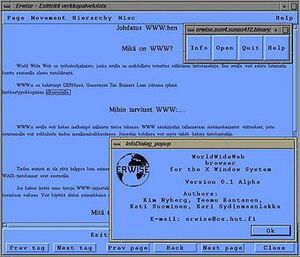Software:Erwise
 Screenshot of the browser | |
| Initial release | 0.1 / 15 April 1992 |
|---|---|
| Final release | 0.1
/ 25 April 1994 |
| Written in | C |
| Available in | English |
| Type | web browser |
| License | Public Domain |
Erwise is an early discontinued web browser, and the first that was available for the X Window System.[1][2]
Released in April 1992, the browser was written for Unix computers running X and used the W3 common access library.[3] Erwise was the combined master's project of four Finland students at the Helsinki University of Technology[4] (now merged into Aalto University): Kim Nyberg, Teemu Rantanen, Kati Suominen and Kari Sydänmaanlakka.[5][6][7] The group decided to make a web browser at the suggestion of Robert Cailliau, who was visiting the university,[8] and were supervised by Ari Lemmke.
The development of Erwise halted after the students graduated and went on to other projects.[6] Tim Berners-Lee, the creator of the World Wide Web, travelled to Finland to encourage the group to continue with the project. However, none of the project members could afford to continue with the project without proper funding.[6]
The name Erwise originates from otherwise and the name of the project group, OHT.[8][9][10]
Development
For the web to be popularized, Tim Berners-Lee knew that what people wanted was a GUI-based browser – one that could target multiple operating systems, and most importantly, be easy-to-use for the technologically challenged. At the time, personal computers were also confusing to some people that were not experienced with technology.
History
- Extremely pre-documented (in Finnish).[9]
- Serious coding started around March 1992.[9]
- Alpha release available by anonymous FTP from info.cern.ch—binaries only (sun4 works, decstation too, display requires Motif) as of 15 April 1992.[9]
- Source code released on www-talk August 92.[9]
Characteristics
The following are significant characteristics of the browser:
- It used a multi-font text.[6]
- The links of Erwise browser were underlined. To visit the links you had to double click on the links.[6]
- Erwise could execute multiple window operation, though the optional single window mode was also available.
- Erwise could open local files.[6]
- Erwise had little English documentation.
- Some of the buttons were for features that were not implemented.
- Tim Berners-Lee would have continued with the works of Erwise.[1] He could not do so because Erwise's code was documented in the Finnish language.[11]
Criticism
Erwise crashed on some versions of Unix, which Berners-Lee attributed to poor Motif implementations.[6][12]
See also
References
- ↑ Jump up to: 1.0 1.1 Holwerda, Thom (3 March 2009). "The World's First Graphical Browser: Erwise". OSNews. http://www.osnews.com/story/21076/The_World_s_First_Graphical_Browser_Erwise.
- ↑ "Cern Authentication". http://cnlart.web.cern.ch/cnlart/2001/001/www-history/.
- ↑ "Computing at CERN in the 1990s". cerncourier. 7 September 2006. http://cerncourier.com/cws/article/cnl/25822.
- ↑ Tim Berners-Lee. "What were the first WWW browsers?". World Wide Web Consortium. http://www.w3.org/People/Berners-Lee/FAQ.html#browser.
- ↑ Cite error: Invalid
<ref>tag; no text was provided for refs namedneww3c - ↑ Jump up to: 6.0 6.1 6.2 6.3 6.4 6.5 6.6 Cite error: Invalid
<ref>tag; no text was provided for refs namedcomparison - ↑ "The Greatest Internet Pioneers You Never Heard Of". Xconomy.com. 3 March 2009. http://www.xconomy.com/national/2009/03/03/the-greatest-internet-pioneers-you-never-heard-of-the-story-of-erwise-and-four-finns-who-showed-the-way-to-the-web-browser/.
- ↑ Jump up to: 8.0 8.1 Stewart, Bill. "Web Browser History". Living Internet. http://www.livinginternet.com/w/wi_browse.htm.
- ↑ Jump up to: 9.0 9.1 9.2 9.3 9.4 "Status of "Erwise" browser". World Wide Web Consortium. http://www.w3.org/History/19921103-hypertext/hypertext/WWW/Erwise/Status.html.
- ↑ "Helsingin Sanomat" (in fi). 10 February 2000. http://www2.hs.fi/klik/arkisto/2000helmikuu/20000210klik99erwise.html.
- ↑ Gillies, James; Cailliau, Robert (2000). How the Web was Born: The Story of the World Wide Web. Oxford: Oxford University Press. p. 211. ISBN 0-19-286207-3. https://books.google.com/books?id=pIH-JijUNS0C&pg=PA211.
- ↑ Tim Berners-Lee. "Viola and Erwise". World Wide Web Consortium. http://www.w3.org/History/19921103-hypertext/hypertext/Erwise/vsViola.html.
Sources
- Berners-Lee, Tim: Weaving the Web ISBN:0-694-52125-6.
External links
- The source code at FUNET FTP archives
 |

